We’ve had moments where everything looked fine in WordPress, but the post link showed a 404 error instead. No changes to the content — just a missing page that should have been there.
This usually pops up after tweaking settings, switching themes, or adding code that silently affects permalinks. It can catch you off guard, especially if the rest of your site is working perfectly.
Whenever we run into unexpected 404 errors, we follow a simple process to get the post URLs back on track — no guesswork, no heavy troubleshooting. And that’s exactly what we’re sharing with you in this guide.
You’ll be able to fix the 404 errors and make sure your posts are loading the way they should.

Why Are My WordPress Posts Returning a 404 Error?
There are several reasons why your posts might be showing a 404 “Page Not Found” error in WordPress. These can include:
- Plugin or theme conflicts: Sometimes, plugins or themes you’ve installed on your site can interfere with how WordPress handles permalinks. This can lead to broken links and 404 errors.
- Custom code issues: If you’ve added custom code to your website, there might be errors in the code that are affecting permalinks or causing other conflicts, resulting in 404 errors for your posts.
- Issues with your .htaccess file: The .htaccess file plays a role in how WordPress structures URLs. If this file is corrupted or missing, it can lead to 404 errors for your posts or pages.
How to Find All WordPress Posts With 404 Errors
Before we get to the solutions, it’d be good to figure out if this error is just happening to one or two posts or multiple posts. This way, you can determine the scope of the problem and choose the most appropriate solution.
One easy way to figure this out is to use Google Search Console. If you haven’t submitted your site to Google Search Console already, then read our guide on how to add your WordPress site to Google Search Console.
Once the Google bot has crawled and indexed your site, Google Search Console will then provide you with detailed information about your site’s performance, including any 404 errors it encounters.
To find out which posts are returning 404 errors, you can log in to the Search Console dashboard. Then, navigate to the ‘Pages’ report, and you will see a detailed list of all the errors.
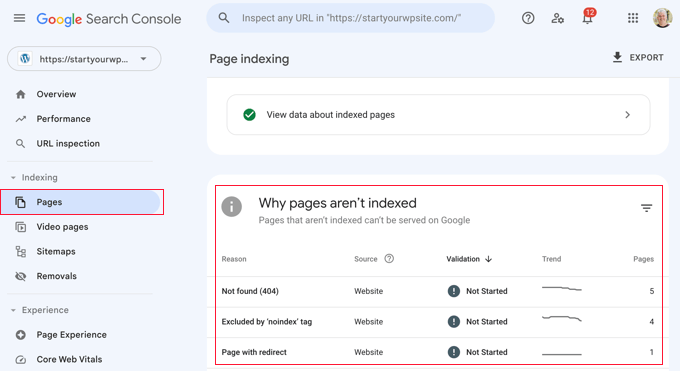
For more information, you can read our list of tips for using Google Search Console to grow website traffic, which includes some tips on how to fix 404 errors with the tool.
That being said, let’s look at how to fix WordPress posts returning 404 errors. You can use the links below to jump straight to different solutions:
- Method 1: Check for Plugin or Theme Conflicts and Custom Code Issues
- Method 2: Fix Your Permalink Settings
- Method 3: Update the WordPress .htaccess File
- Method 4: Contact Your Hosting Provider
- Method 5: Enable mod-rewrite (Local WordPress Installation)
- Frequently Asked Questions About WordPress 404 Errors
- 🎁 Bonus: Additional Guide on Handing 404 Errors
Method 1: Check for Plugin or Theme Conflicts and Custom Code Issues
Sometimes, plugins, themes, or custom code you’ve added to your WordPress website can interfere with permalinks or cause conflicts, leading to 404 errors. We’ve even experienced it ourselves when we’re testing tools on our demo site.
One way to solve this problem is to temporarily deactivate plugins. Plugins can sometimes disrupt how WordPress handles links.
Once you’ve deactivated the plugins, you can reactivate them one by one while checking if the 404 error reappears after activating each plugin. If the error shows up after activating a specific plugin, that might be the culprit.
You can then do a quick Google search for solutions related to that plugin or contact the plugin developer for support.
Similarly, your WordPress theme might be causing the conflict.
To check, you can temporarily switch to a default WordPress theme like Twenty Twenty-Three or Twenty Twenty-Four. All you need to do is go to Appearance » Themes and click ‘Activate’ on a default theme.

If the 404 error disappears with the default theme, it indicates a potential conflict with your current theme. You can then try troubleshooting the theme or consider using a different theme.
You can check out our expert pick of the most popular WordPress themes for recommendations.
If you’ve recently inserted code snippets to your website, there might be errors in the code causing the 404 errors. Take a close look at the code you added and see if you can identify any mistakes.
The safest way to add code snippets to WordPress is with the WPCode plugin. This plugin lets you insert custom code without directly working with the theme files, reducing the risk of breaking your website.
Plus, whenever WPCode spots an error in your code, it will automatically deactivate the snippet and ask you to check it. You can also use the testing mode to check if your code works before pushing it to your live website.

If none of these solutions work, move on to the next method where we’ll troubleshoot your permalink settings.
Method 2: Fix Your Permalink Settings
WordPress posts can return 404 errors because of problems with rewrite rules in your .htaccess file. In most cases, you can fix the problem by updating your permalink settings.
Simply go to Settings » Permalinks in your WordPress admin, and click on the ‘Save Changes’ button.

There is no need to make changes to the permalink settings themselves. This will update your permalink settings and flush the rewrite rules.
In most cases, this solution fixes the WordPress posts 404 error. However, if it does not work for you, then you probably need to update your .htaccess file manually.
Method 3: Update the WordPress .htaccess File
Before you start, make sure to back up your WordPress .htaccess file first. If something goes wrong, you can easily restore the original file.
Now, you’ll need to connect to your server using an FTP client like FileZilla or the File Manager in your hosting control panel.
Next, find the .htaccess file in your site’s root folder—this is the same directory that contains folders like /wp-content/ and /wp-includes/.
Right-click on the file and select ‘File permissions’ or ‘Change permissions’ from your FTP client.
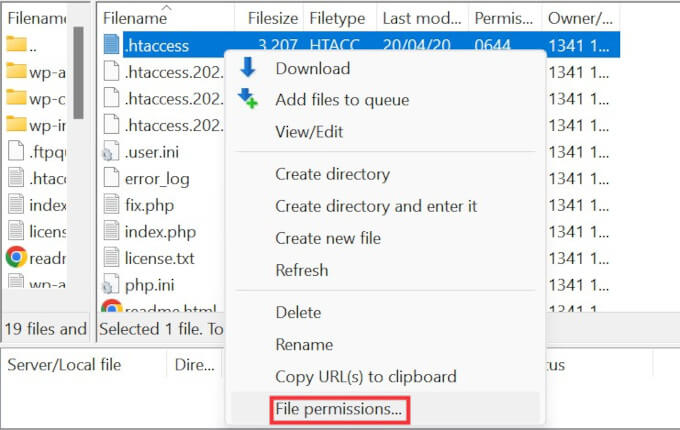
If WordPress couldn’t write to the file before, try changing its permissions temporarily to 666 to make it writable.
After that, go back to your WordPress admin area and resave your permalink settings. This allows WordPress to regenerate a proper .htaccess file.
Once that’s done, make sure to change the file permissions back to a more secure setting: 644. This setting allows WordPress to read the file, while still protecting it from unauthorized changes.

Alternatively, you can manually edit the file.
Simply right-click on the .htacccess file and then select View/Edit option.
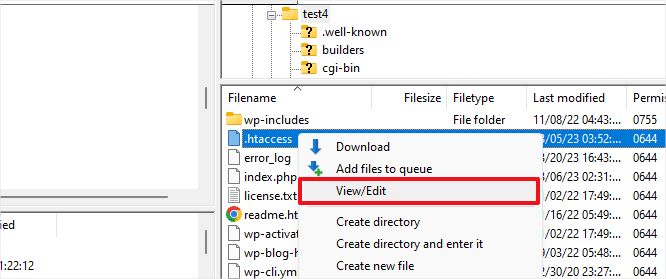
The file will open in plain text editor like Notepad or TextEdit.
Now you need to add the following default WordPress rewrite rules:
# BEGIN WordPress
<IfModule mod_rewrite.c>
RewriteEngine On
RewriteBase /
RewriteRule ^index\.php$ - [L]
RewriteCond %{REQUEST_FILENAME} !-f
RewriteCond %{REQUEST_FILENAME} !-d
RewriteRule . /index.php [L]
</IfModule>
# END WordPress
Method 4: Contact Your Hosting Provider
If neither of the solutions above has fixed the WordPress posts returning 404 error, then we recommend contacting your WordPress hosting provider. There may be an error on their end, or they might be able to help you troubleshoot the problem.
Please also see our guide on how to properly ask for WordPress support and get it.
Method 5: Enable mod-rewrite (Local WordPress Installation)
If you are using a local server for testing purposes, then you will need to enable mod_rewrite in the Apache configuration of your MAMP, WAMP, or XAMPP site.
This will allow WordPress to generate clean URLs and prevent the 404 error for posts and pages on your local server.
How you do this will differ by the platform you use. People using XAMPP can open their control panel and click the ‘Config’ button within Actions. Then, select ‘Apache (httpd.conf).’
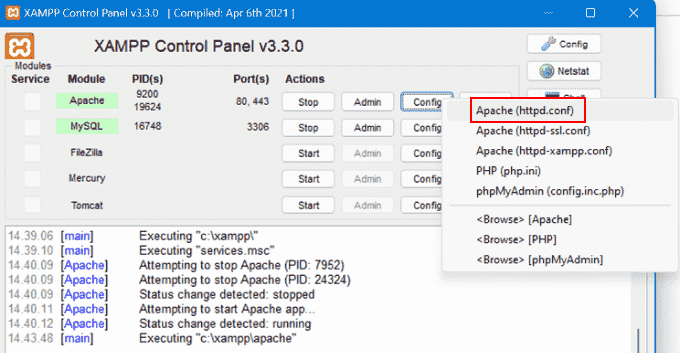
Next, you will need to find this line #LoadModule rewrite_module modules/mod_rewrite.so and remove the ‘#’ to uncomment it.
This will load the mod_rewrite.
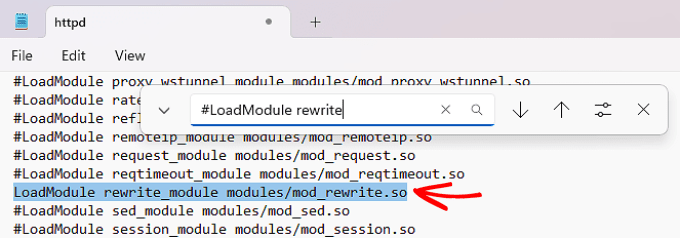
Then, look for lines that say AllowOverride None and change them to AllowOverride All. This tells Apache to allow the use of .htaccess files.
You’ll typically find these inside <Directory> blocks—especially the one pointing to your site’s folder, like htdocs if you’re using XAMPP. If you’re unsure, it’s okay to apply the change wherever you see it inside the file, as long as it’s not a system directory. For local testing, this usually works just fine.

Once done, you can save the httpd.conf file and close it. After that, in the XAMPP control panel, click ‘Stop’ on the Apache module and ‘Start’ again to restart it.
Then, go back to your admin dashboard to see if your permalinks are working.
Video Tutorial
If you need visual instructions, then just watch the video below.
Frequently Asked Questions About WordPress 404 Errors
Encountering 404 errors on your WordPress site can be confusing. Below, we’ve answered common questions that can help you troubleshoot and fix the issue more effectively.
1. Why am I getting a 404 error on my WordPress posts?
This usually means WordPress can’t find the post at the requested URL. It can happen due to broken permalinks, a corrupted .htaccess file, deleted posts, or a plugin/theme conflict that changes how URLs are handled.
2. How do I fix a 404 error in WordPress?
Try resaving your permalink settings by going to Settings » Permalinks and clicking ‘Save Changes’. If that doesn’t work, check your .htaccess file, disable plugins, or switch to a default theme to rule out conflicts.
3. How can I find all 404 errors on my WordPress site?
You can use Google Search Console to see a list of 404 errors Googlebot encounters. Plugins like Broken Link Checker can also help spot broken links and missing pages inside your site.
4. What does the .htaccess file do in WordPress?
The .htaccess file controls how URLs are processed. WordPress uses it to manage permalink structure and route URLs to the correct content. If it’s missing or corrupted, URLs may stop working correctly.
5. How do I safely edit the .htaccess file?
You can edit it using an FTP client or your hosting file manager. Always back it up first. After editing, make sure the permissions are set to 644 so it stays readable and secure.
6. Why do my WordPress category or tag pages show 404 errors?
This can happen if your theme doesn’t support archive templates, or if permalink settings are misconfigured. Resaving permalinks and checking your theme’s archive support can help fix it.
7. How do I fix 404 errors for custom post types?
Visit Settings » Permalinks and click ‘Save Changes’ to refresh rewrite rules. Also, check that your custom post type is registered with the right rewrite settings and has archive support if needed.
8. Can I redirect 404 pages to my homepage or another page?
Yes, plugins like Redirection let you create 301 redirects from old or broken URLs to new ones. You can also create a custom 404 page to guide users back to useful content.
🎁 Bonus: Additional Guide on Handing 404 Errors
You may also find the following resources helpful in managing 404 and other common WordPress errors.
- How to Improve Your 404 Page Template in WordPress (2 Ways)
- Best WordPress 404 Error Page Design Examples
- Best Free 404 Redirect Plugins for WordPress
- How to Get Email Alerts for 404 Errors in WordPress
We hope this article helped you resolve the posts returning 404 errors in WordPress. You may also want to see our guide to the most common WordPress errors and how to fix them, along with our expert picks for the best WordPress plugins to grow your site.
If you liked this article, then please subscribe to our YouTube Channel for WordPress video tutorials. You can also find us on Twitter and Facebook.





Rj
thanks man u saved my life
Phannipha
Thank you for very useful sharing. Just only one click can solve the problem:)
Ehiz Mikey
A million thanks Syed. I was stuck here for a couple of weeks. A fix indeed.
Kaycee
Hi. Really nice article.
I had a 500 internal server error issue with my site when I tried using the W3 Total Cache plugin.
To fix this, I renamed the .htaccess file to .htaccessbak. After doing this, I noticed that the 500 error cleared but then I got a 404 error! All the links and pages on my site returned a 404.
On the All Pages section, I see a link that says “Purge from cache”
Please what do I do to clear this issue?
Stanley
You’re a life saver, worked for me.
Really grateful,
Thank you
syed
thanks it works for me….
Christian Fraunholz
but why is that happening and how to fix it forever?
Karma
I tried to follow your direction in fixing my problem, it took for about a day, but I didn’t find the good result.
Then I gave up and contacted my hosting. And it fixed only in 5 minutes. Lol the problem came from the hosting…
Mark Kay
By careful with post variables names. I had a contact form with an input field called “name”, that caused WordPress to show the 404 page. Took me a long time to figure out the problem. I fixed it be changing the field name from “name” to “your-name”.
Ivan
thanks you saved my life.
Ramzan
My problem is that I m going to wp adminin
And want to edit post it is not going in edit mode of post and page gives me error page not found 404 but my site and its pages are opening well in browser
Plz guide me I can solve this problem
Ben
Samo rpoblem here. Cannot edit the existing posts or add new one. I get 404 for both
Sunit
Hi, I have tried following the above steps but my issue is this: when I visit my website directly by putting typing the url, then it works fine. But, when i type in my site url in google search box and then click on the link from the search results, I get the 404 error or message saying “your connection is not private”.
My website is http://www.example.com but google search result shows it as https://example.com/
So not sure what the issue is. I used to have wordpress.com but now I am dong self-host using HG.
Any help will be appreciated.
Thanks
WPBeginner Support
www is considered a subdomain of a domain. So basically a site with www and without www will be considered two different sites by search engines. Go to Settings > General page to change your site URL from http://www.example.com to just example.com.
WordPress.com enabled https for all custom domains on WordPress.com. This means Google had already crawled your website with https in the URL. You can install free https using Let’s Encrypt.
Admin
Paul Nicholson
Great worked for me thanks!!
Shashdhar S
Thanks a lot , the second option worked for me ….. Thank you so muich
eliana
Just THANK YOU!
eli
WPBeginner Support
You are welcome Don’t forget to follow us on Twitter for more WordPress tips.
Don’t forget to follow us on Twitter for more WordPress tips.
Admin
Michaela
hi, I tried first solution, nothing happened. I wanted to try the second, but I cannot find the .htaccess file. Not in FTP, not even in my WP online editor. I had this issue today for the first time. I use WPML plugin, until now everything went without problem, but today my translated post in English throws this 404 Error. Any idea what shall I do if I cannot locate the .htaccess file?
Thanks!
Michaela
I noticed one thing. The post in the editor shows me the following link:
example.com/2016/09/15/where-eat-in-barcelona/?lang=en
but when I click to see the post, or from any RSS feed click on the published post, the link showing 404 error is as follows:
example.com/?p=11409&lang=en
WPBeginner Support
Please take a look at our guide on why you can’t find .htaccess file on your WordPress site.
Admin
Shirish Dhungel
Well thanks! I remember, that WP Super Cache official stated to remove rewrite code from .htaccess. After that, my posts redirected to 404. Thanks to you, now my site is perfectly fine.
Muhammad Nasir
Thanks it worked for me, thank you so much.
Akhelesh
Do I have to remove the code snippet I added to htacces file after my problem has been solved?
Jessica
Can someone contact me please? I am so new to these I don’t even know what a FTP server is…
WPBeginner Support
Please see our guide on using FTP.
Admin
Rohan khamkar
Sir, when I post a new post it gives me error that 404 page not found. Previously everything was fine but when I add a new user and give him a role of administrator from that time I can’t post new post. Any solution Please. Thank you in advance.
WPBeginner Support
You should never give administrator role to a user you don’t trust. You can always change back their role by going to Users page and then clicking on the Edit link below the user that you want to change. After that you check your site’s permalink structure. See if they installed any new plugin and if they did, then deactivate that plugin.
Admin
Shivani Sehdev
Wow……….. Solved a long ago problem .
Thanks A lot.
R Donahoo
Didn’t work on my apache server. Had an additional step to allow mod_rewrite to actually work. Edit your httpd.conf file and add ‘Allowoverride all’. For example:
DocumentRoot /var/www
find the section that sets up the directory options, such as:
Options Indexes FollowSymLinks MultiViews
Order allow,deny
allow from all
add Allowoverride all
Options Indexes FollowSymLinks MultiViews
AllowOverride all
Order allow,deny
allow from all
save and restart the web server to re-read the updated configuration.
All was well after that.
Thanks for your useful post moving me into the right direction.
Arnaud
forgot about htis #yaDaMan
Ben
Didn’t work for me either
Where can I find this file you are talking about
aderele olutayo samuel
this worked. …. Thanks
Eva
I found the some problem. However, I could not log in to the admin page. Could you give solution to mitigate this problem?
Rodrick Green
This was very easy and very helpful. THANKS A LOT!!!
B Pandey
thanks for your usefull tip. It worked for me on my website. Thanks a lot
sheldon
Thank you .
It worked for me
Rachit Sharma
but not working for me when i updated permalink with post name and change .htcces file but not worked. any other solution for that.
Ahsan
Wowww Thank you so much, that was really helpful.
In my case it was WAMP server, after turning on “rewrite module” in apache, my problem was solved.
Thanks.
Kailash
Wow – this still works. Done a search on google and found articles in wordpress but this was by far the simple-est and bang it works.
Thanks a mill – saved me a heap of time
WPBeginner Support
Glad you found it helpful.
Admin
Shawn Ritch
Hello and thanks for all the useful tips. Unfortunately, this tip didn’t work for me. I re-saved my permalinks in WordPress settings (didn’t work) so then I tried your next method and it didn’t work either. I’m thinking the reason for this is because I have different permissions. My original permission is 644. When I change permission to 660 none of my pages work so I believe the 666 permission is wrong as well. I’m using a Go Daddy server if that helps any :/
I’m at a loss and have no idea what to do from here. However, I can’t afford to have pages that don’t work. Any suggestions would be greatly appreciated.
Thanks
Shawn Ritch
Kevin Garcia
I tried this and it didn’t help me!!! My whole website crashed and had to restore it!!
Hannah Brown
Thanks, yours was the only place that told me HOW to fix my broken links! You’re the best
WPBeginner Support
Glad you found it helpful.
Admin
Kunal Yande
Thanks !!
You save my so much time….
Chris
How do I fix the issue when I upload a new plugin and then my categories, not posts, become 404?
Bob
This is great advice. I thought I was going to have to take a deep dive, but two clicks and I’m GTG. Thanks!
Ronn Reason
hi
i keep getting this message with my email account;
Error Oops… a server error occurred and your email was not saved. (#404)
Please advise ASAP
Gabo
O.O
I can’t belive this …. it works, thanks !!!!!
Steve
I had this problem after moving sites to a new server. Default Permalinks worked, but not the settings I was using.
I needed the apache server to “Allow Override” for the htaccess file to take effect.
Vivek
Hi,
I need a little help regarding 404 error.
I am getting 404 error in my Page 2 section.
I have googled a couple of times. but did not get the solution.
Could you please tell me what is the reason for it?
Rudy
My site links will work ONLY after I’ve VIEWED the permalink settings, without any changes, and Voila! The links work again. What is causing this and how can I program this instead of having to log in?
I’ve tried the following commands in WP-CLI to no avail:
wp rewrite flush –hard –path=c:\xampp\htdocs\mywordpress
wp cache flush –path=c:\xampp\htdocs\mywordpress
Amit Schandillia
This saved my life!!!!!
Patrick
Thanks man, just pressing the “Save changes” on the permalink-settings page did it for me! Cheers!
Amanda
Hi there,
About an hour ago I was able to remedy a pesky ‘500 Internal Service Error’ by following your sage advice and renaming the .htaccess file to .htaccess_old. I was immediately able to access my wp-admin area–and I thought–get going again.
Unfortunately, something happened which rendered all of my other pages unfindable; each kicking a 404 error.
I attempted the steps you provided above, but to no avail. Might you have any further suggestions?
Thank you.
Jessa
You guys are awesome, this was easy and fast. You guys save me a trouble!
mehdi
why i coudl not see my post?
after I send a post my preveous posts appear.
it made me crazy please remove previous post
…
I found a solution to my problem and will say in next post
mehdi
Hello agin
thank you for this useful article/ I found a bug in wordpress in rtl language in displaying permalink
I read your article and encourage to solve the problem with your contribute.
——————————————
my problem in detail:
1-I created a mysql database(in utf8 general ci)
2-I installed last wordpress versin(locally) and install my theme(multiup v 1.2 from themeforst)
3-Next I did import demo as whele.
in the theme admin panel exixst category portfolio (in this section we create our category with name and slug) then in all post under portfolio section we can create our posts and determine category of post from portfolio category) finally in homepage we have a section that shows portfolio post in category(with their picture)
In english slug and name the category of portfolio show well but when i change category in portfolio category( slug) into rtl language the category in homepage canvert into charachter like base 64(I think that my slug convert into ansi ie each character convert into 6 charachter)
How I can overcome my problem?I think I must avoid change slug or show slug into utf8 or unicode . I am beginer in wpordpress , If I khnew wordpress more I could solve this simple problem .Any one with khnowledge of handling hoock and filter and plugin and wordpress can solve this permalink problem . I sure I will solve this problem with your help.
———————————-
I tried the second way you offer (that phpmyadmin in utf8generalci) but it doee not work for me.
before thansk a lot for helping me.I followed your posts regularly .
……………………………….
1- first I did the trick in above article (this is so good but didnot solve my problem)
2-
mehdi
hello
thanks to contribute you knowledge to others .my english is not well.excuse me.
I download a wordpress theme with portfolio link in admin panel that in porftoli section we can define some category with name and slug . in post we can determine category from portfolio.
in homepage we can display post in portfolio category! all thing is ok but wen i chang name and slug into rtl language the title of a group in home page shows like this %d8%a8%d8%b1%d9%86%d8%af%d8%b3%d8%a7%d8%b2%db%8c
i did your solution in this topic and that another topic(How To Enable Custom Permalinks) but not woks for my problem!
WPBeginner Support
This could happen if your WordPress database is not using UTF-8 character encoding. Please make sure that your database is using utf8_general_ci as collation. You can check that using phpMyAdmin from cpanel. Before you make any changes to your database, please create a complete WordPress backup first.
Admin
Atula Gupta
Thank you so much for fixing my problem in seconds! I was panicking about all my posts giving this error and this solution was so simple! Thanks again.
Sammy
Thank you, thank you! This was making me crazy and you just helped me fix it in 2 seconds. High five.